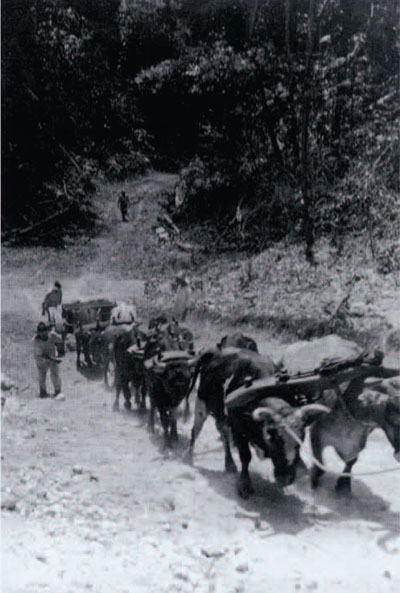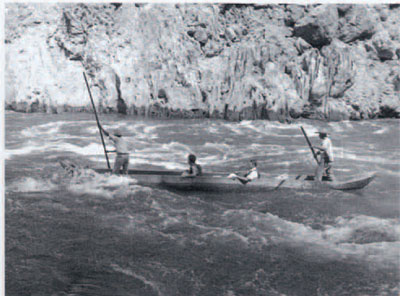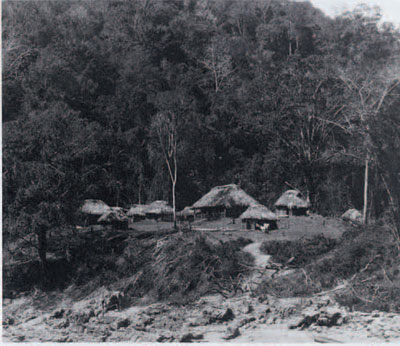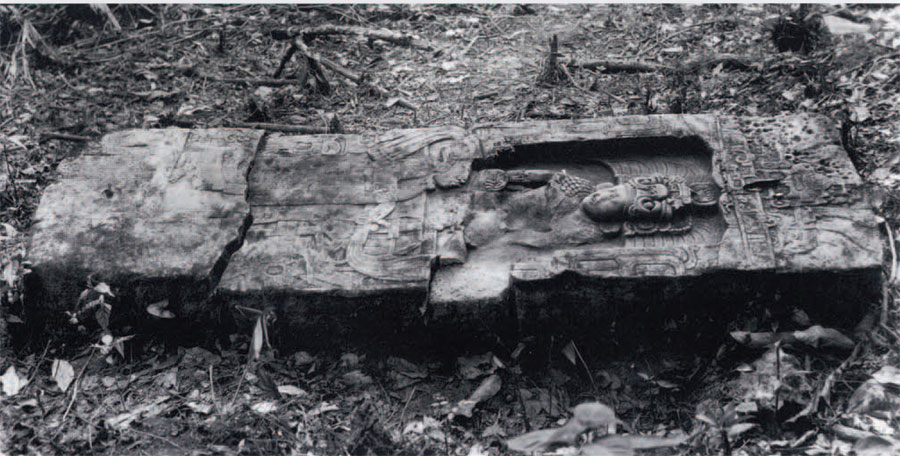
UPM Neg. NC35-15999
Today when the Internet is almost ubiquitous and air travel is as common as a walk down the lane, it’s difficult to grasp the immense difficulties that Mayanist archaeologists faced in the early years of the l9th century. The University of Pennsylvania Museum’s excavation of Piedras Negras provides both a reminder of those early days and a cautionary tale of innocence and hard-won experience.
Piedras Negras had been discovered at the end of the 19th century and its magnificently sculptured monuments photographed by Teobert Maler (1842-1917; pioneer Austrian archaeologist and explorer), but thereafter no further exploration had taken place. In 1930 the University Museum fixed upon the site for its first institutional expedition to the Maya region. The decision was based on the existence of the sculptured monuments and the location of Piedras Negras on the Usumacinta, a great river that drains much of Guatemala. Up to that time, no large Maya sculptures had been removed from their overgrown rainforest sites. J. Alden Mason (Fig. I), the young archaeologist who negotiated the Museum’s contract with Guatemala, obtained permission for excavation and for the removal of the monuments, half to be sent to the museum in Guatemala City and half to Philadelphia on long-term loan. Piedras Negras is only about thirty miles above the head of navigation on the Usumacinta. In order to get the monuments to the navigable portion of the river (Figs. 2, 3), Mason planned to build a road around the falls and rapids, a task he thought would take only part of the first season (Fig. 4). In fact, it took the entire season.

UPM neg. 15690.
Although an experienced archaeologist, Mason had never before worked in the Petén rainforest; indeed, very few archaeologists had. The first institutional excavation in that difficult terrain was begun by the Carnegie Institution of Washington in 1926 at Uaxactun, where they would continue to work until 1937.
The community of Mayanist archaeologists was a small, close-knit group and cooperation was always available. Oliver Ricketson of the Carnegie provided Mason with his own field-tested knowledge and compiled a manual for the untried Museum team. “Information for Expeditions Based on Belize” covered 19 pages with single—spaced typed instructions that included everything to be done when planning for the field, from supplies to take and buildings needed (and how to build them), to the detailed design for constructing saddle bags (Fig. 5), and a recipe for making flour tortillas. When the Piedras Negras camp buildings (Fig. 6) burned in 1932 the pages were charred, but the manual survived and now resides in the University Museum’s Archives along with the expedition’s field notes and original photographs (Expedition Records, Piedras Negras, Box 1, Correspondence—Ricketson 1931-32).

UPM neg. 17531

UPM neg. 15584.
Ricketson’s first admonitions dealt with the problems of maneuvering through the regulations of three separate governments. Because the group would come into Guatemala through British Honduras (now Belize), and have to export via Tenosique in Mexico, the bureaucracy of three countries had to be considered, export and transfer documents arranged, permits shown and credit approved, different firearms permit requirements complied with, and bonds posted.
That archaeology in the region was in its infancy is clear from Ricketson’s comments (because of the charring, some words at the edges of the page are obscured, and their absence indicated by ___):
Excavations in the Maya area have so rarely covered a period of ___ seasons at the same site that no well-defined, conventional technique ___ attacking a large city had been developed when I undertook to execute excavations for the Carnegie Institution of Washington at Uaxactun in ___. Informal inquiries among Maya students did not seem to elucidate many specific details as to where to begin, or how.
He then listed some of the techniques that had worked for him, including this warning:
In the examination of stela at Uaxactun, caches were found under ___ of the monuments. In no case were any of the monuments set up on el[evated] foundations and in one case the stela stood only 6″ in the ground. __ procedure consisted in sinking a pit beside the short axis of the mon[ument] and from thence trenching to the monumentand to the building behind it if any. The caches–almost always flint, obsidian, or shell–were first found by carefully digging under the stela, but this so narrowly resulted in a fatal accident in the case of Stela 4 that thereafter the stelae were pulled over with a block and tackle after their relat[tion to] the floor or floors had been determined. A limestone monument of 8 ft by 4 ft wide by 2 ft thick weighs about 10,700 lbs. [See Fig. 7]

UPM Archvies. Piedras Negras Expedition Records

UPM neg. 15506
In among the pages of professional advice were some personal comments, such as: “Remember that excessive perspiration and the treatment of corded linen in washing causes rapid disintegration; do not expect clothes already old to last the season.” Along with a complete list of personal items needed for each staff member, he gave Mason the benefit of his comparison shopper tips: “Each individual of the staff should be supplied with…1 ‘Nyack’ for personal use. These are cases of fibre, to be bought ready made at Abercrombie and Fitch, N.Y., but those made to order at Topham’s, Inc., Washington D.C. are better and cheaper.”
Among some thirty items such as aspirin, codeine, quinine. “potassium iodide for the treatment of Leishmania (Poison. Consult a physician),” and the understandable bottle of brandy, is “such invalid supplies as…chicken broth.” His comforting note that “on the whole little sickness will be met during the dry season except malaria, infected cuts or insect bikes] and digestive upsets” is followed by “Ether and Anaesthol is included [in the medical list] on account of its effectiveness in removing beef-worms [from beneath the skin] rather than as a general anaesthetic.”
Under the heading, “Food for Staff,” in addition to listing the provisions required for a staff of four persons for a field season of 15 weeks, Ricketson supplied average menus, with quantities, for four persons, and noted that “As there is a great difference in quality in the various marks of tinned foods sold in Belize, it may be of value to note here those which we have found best.” The makers of Maxwell House coffee, Pet milk, Horlick’s Malted, and Del Monte vegetables, among other well-known brands of canned goods in the early 20th century, would have been pleased!

UPM neg. 15544

UPM neg. S4-140749 Museum Object Number: L-16-382
His recipe for flour tortillas could be followed by even an inexperienced cook: “2 cups flour, I teaspoonful soda, 2 tablespoons lard, work into dough with a little water, roll flat, cut into pieces about size and shape of a saucer, bake on a smoking griddle.”
Ricketson assured Mason that his information would allow the expedition to “proceed fully supplied and equipped and without having omitted any detail necessary for the successful completion of its objective.” Mason’s penciled checkmarks and comments in the margins show his careful reading of the contents.
The decade-long Museum expedition is now part of the history of Maya exploration (Fig. 8). Very little has changed for archaeologists planning a field season in the rainforests of Central America. To Ricketson’s comments about the eternal nature of bureaucracy and disease, one of Mason’s comments about the weather provides a suitable postscript: “If this is the dry season, God preserve the inhabitants in the rainy season.”
